Camden Snow Bowl project remains under DEP scrutiny, making progress, more work ahead
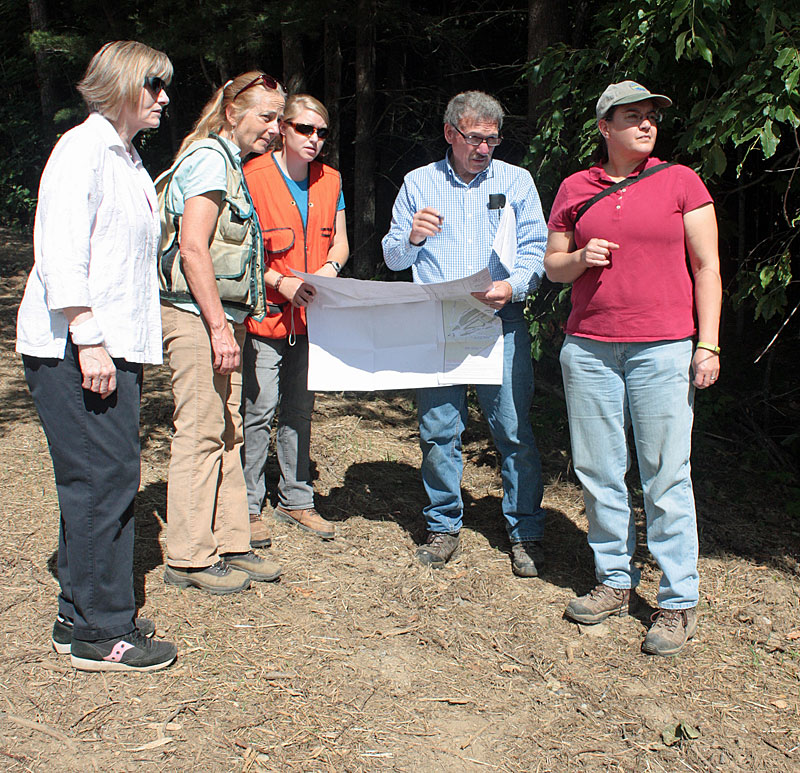 From left, Camden Town Manager Patricia Finnigan, Barrie Brusilla of Mid-Maine Forestry, Maine Department of Environmental Protection Field Services Enforcement officer Jen Harris Dave Marceau, a soil scientist with Gartley & Dorsky, and DEP Licensing and Compliance Manager Dawn Hallowell. (Photo by Holly S. Edwards)
From left, Camden Town Manager Patricia Finnigan, Barrie Brusilla of Mid-Maine Forestry, Maine Department of Environmental Protection Field Services Enforcement officer Jen Harris Dave Marceau, a soil scientist with Gartley & Dorsky, and DEP Licensing and Compliance Manager Dawn Hallowell. (Photo by Holly S. Edwards)
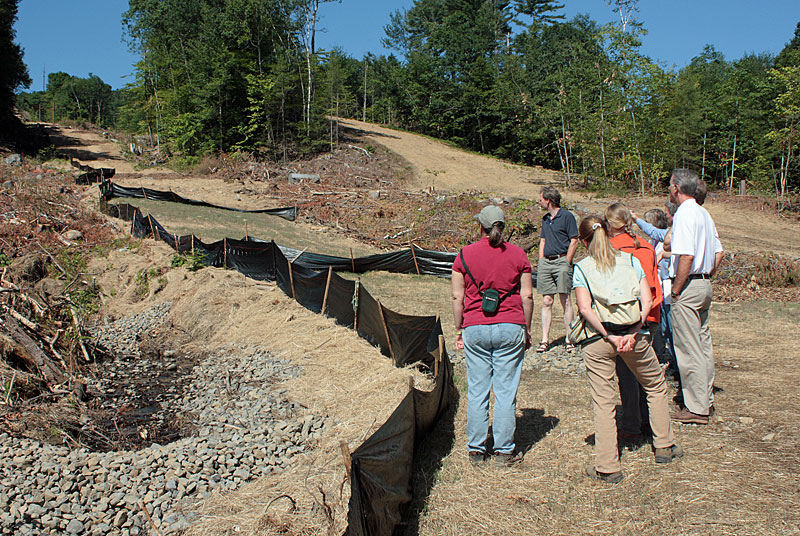 Maine Dept. of Environmental Protection Licensing and Compliance Manager Dawn Hallowell, far left, looks up the newly hay-covered Ragged Mountain slopes, which also have a series of water bars and silt fencing in place. (Photo by Holly S. Edwards)
Maine Dept. of Environmental Protection Licensing and Compliance Manager Dawn Hallowell, far left, looks up the newly hay-covered Ragged Mountain slopes, which also have a series of water bars and silt fencing in place. (Photo by Holly S. Edwards)
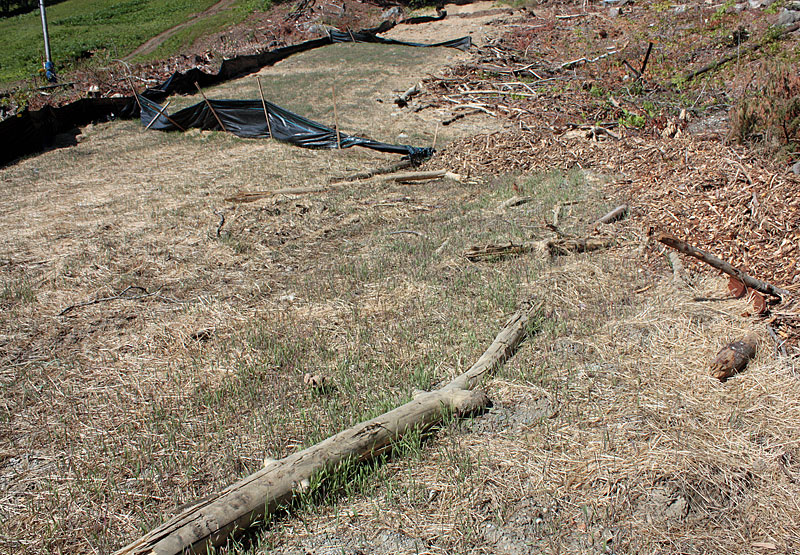 Shoots of oatgrass are beginning to cover previously bare ground on Ragged Mountain. (Photo by Holly S. Edwards)
Shoots of oatgrass are beginning to cover previously bare ground on Ragged Mountain. (Photo by Holly S. Edwards)
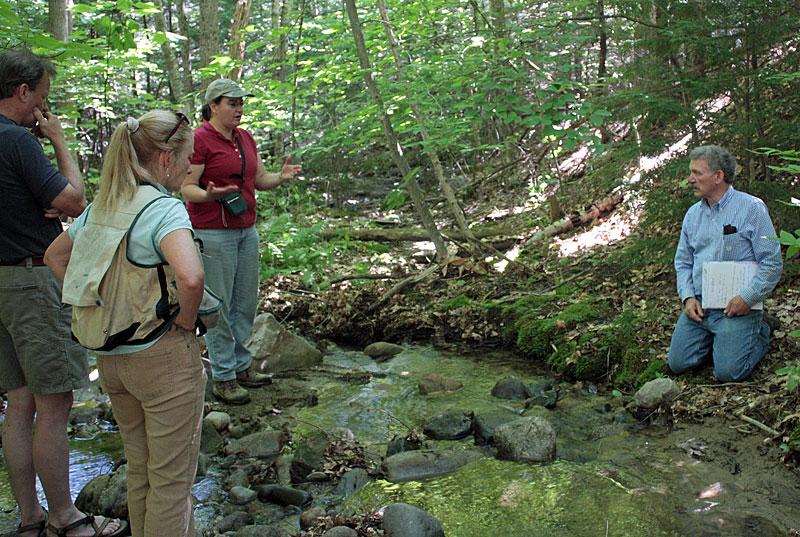 Licensing and Compliance Manager Dawn Hallowell, red shirt, stands on a silt mound in Hosmer Brook Thursday. (Photo by Holly S. Edwards)
Licensing and Compliance Manager Dawn Hallowell, red shirt, stands on a silt mound in Hosmer Brook Thursday. (Photo by Holly S. Edwards)
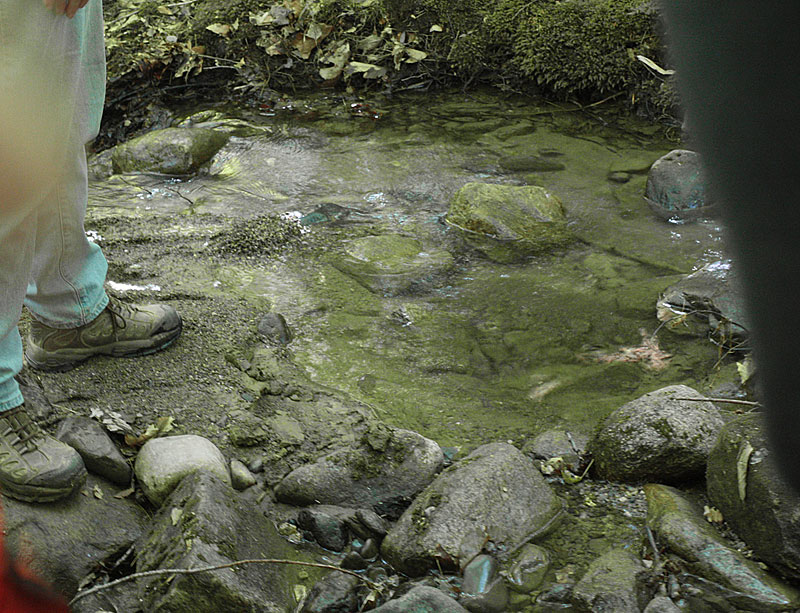 Silt runoff that remains in Hosmer Brooks Thursday. (Photo by Holly S. Edwards)
Silt runoff that remains in Hosmer Brooks Thursday. (Photo by Holly S. Edwards)
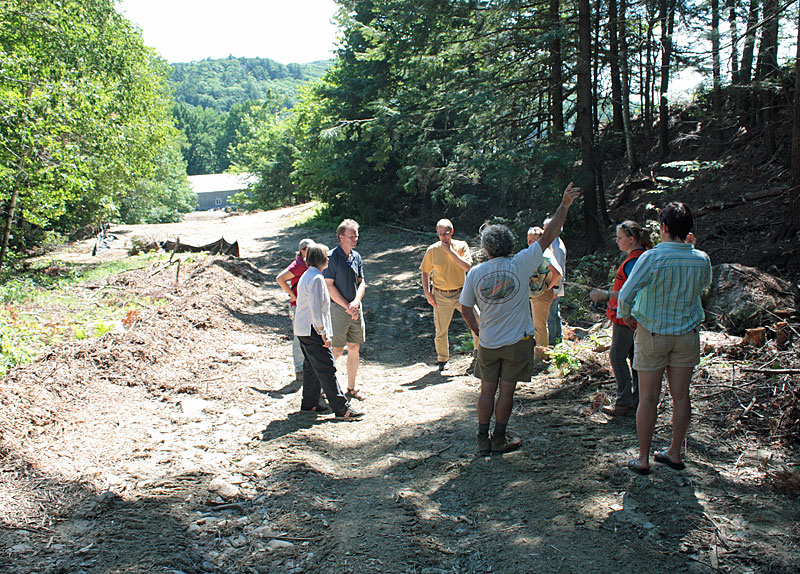 (Photo by Holly S. Edwards)
(Photo by Holly S. Edwards)
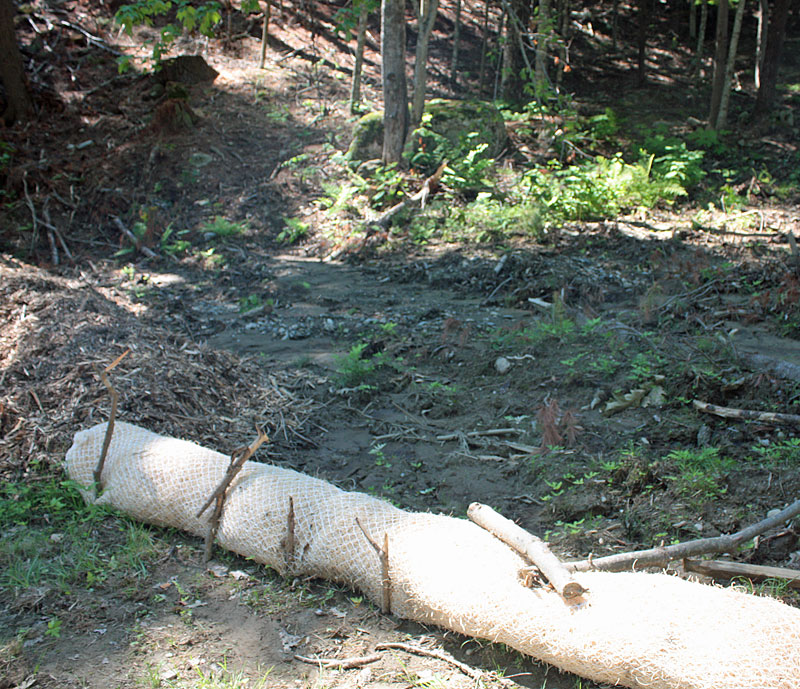 Erosion tubes, or booms, are used to both filer out silt and help direct rainwater flow. (Photo by Holly S. Edwards)
Erosion tubes, or booms, are used to both filer out silt and help direct rainwater flow. (Photo by Holly S. Edwards)
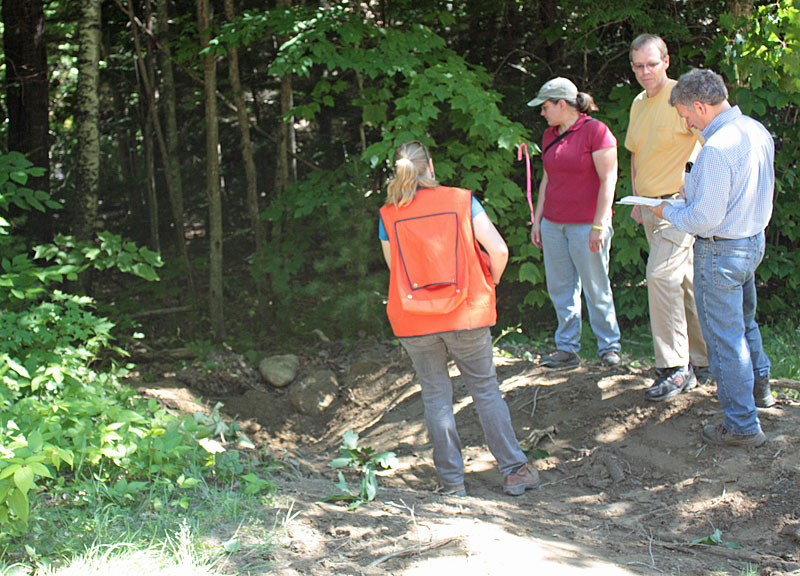 Checking out a water bar. (Photo by Holly S. Edwards)
Checking out a water bar. (Photo by Holly S. Edwards)
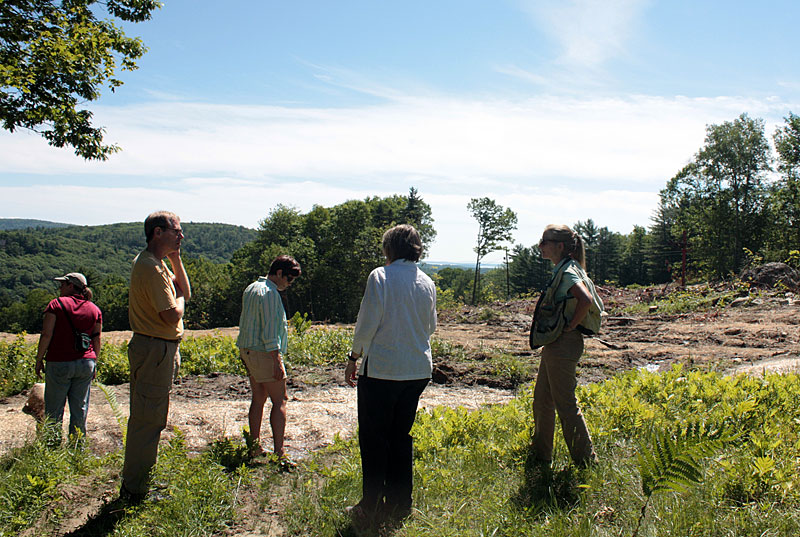 The view on Ragged Mountain is just one of the many things that makes this a popular recreation area. (Photo by Holly S. Edwards)
The view on Ragged Mountain is just one of the many things that makes this a popular recreation area. (Photo by Holly S. Edwards)
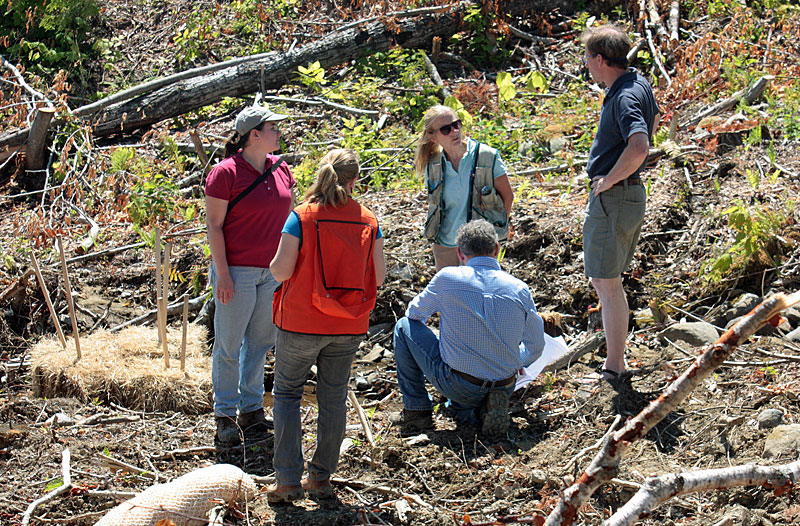 Checking out a wet area, that could be a ditch runoff, or a stream or spring. (Photo by Holly S. Edwards)
Checking out a wet area, that could be a ditch runoff, or a stream or spring. (Photo by Holly S. Edwards)
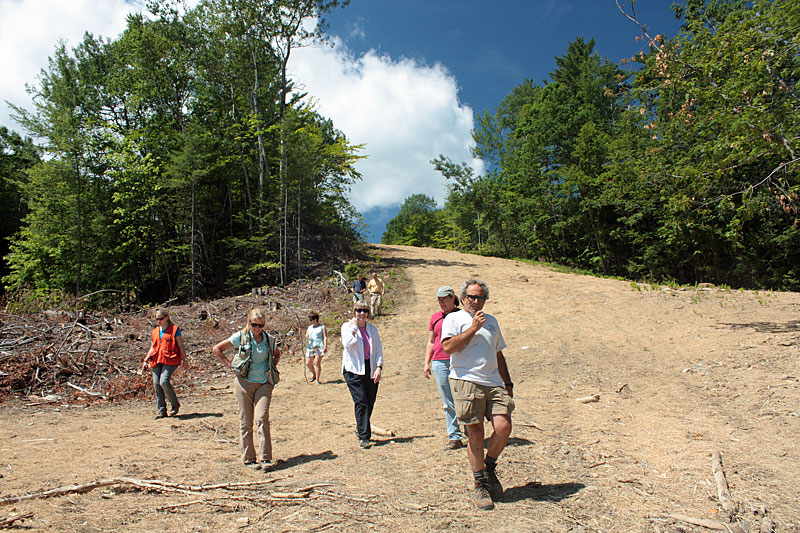 Heading back down Ragged Mountain Thursday. (Photo by Holly S. Edwards)
Heading back down Ragged Mountain Thursday. (Photo by Holly S. Edwards)
 From left, Camden Town Manager Patricia Finnigan, Barrie Brusilla of Mid-Maine Forestry, Maine Department of Environmental Protection Field Services Enforcement officer Jen Harris Dave Marceau, a soil scientist with Gartley & Dorsky, and DEP Licensing and Compliance Manager Dawn Hallowell. (Photo by Holly S. Edwards)
From left, Camden Town Manager Patricia Finnigan, Barrie Brusilla of Mid-Maine Forestry, Maine Department of Environmental Protection Field Services Enforcement officer Jen Harris Dave Marceau, a soil scientist with Gartley & Dorsky, and DEP Licensing and Compliance Manager Dawn Hallowell. (Photo by Holly S. Edwards)
 Maine Dept. of Environmental Protection Licensing and Compliance Manager Dawn Hallowell, far left, looks up the newly hay-covered Ragged Mountain slopes, which also have a series of water bars and silt fencing in place. (Photo by Holly S. Edwards)
Maine Dept. of Environmental Protection Licensing and Compliance Manager Dawn Hallowell, far left, looks up the newly hay-covered Ragged Mountain slopes, which also have a series of water bars and silt fencing in place. (Photo by Holly S. Edwards)
 Shoots of oatgrass are beginning to cover previously bare ground on Ragged Mountain. (Photo by Holly S. Edwards)
Shoots of oatgrass are beginning to cover previously bare ground on Ragged Mountain. (Photo by Holly S. Edwards)
 Licensing and Compliance Manager Dawn Hallowell, red shirt, stands on a silt mound in Hosmer Brook Thursday. (Photo by Holly S. Edwards)
Licensing and Compliance Manager Dawn Hallowell, red shirt, stands on a silt mound in Hosmer Brook Thursday. (Photo by Holly S. Edwards)
 Silt runoff that remains in Hosmer Brooks Thursday. (Photo by Holly S. Edwards)
Silt runoff that remains in Hosmer Brooks Thursday. (Photo by Holly S. Edwards)
 (Photo by Holly S. Edwards)
(Photo by Holly S. Edwards)
 Erosion tubes, or booms, are used to both filer out silt and help direct rainwater flow. (Photo by Holly S. Edwards)
Erosion tubes, or booms, are used to both filer out silt and help direct rainwater flow. (Photo by Holly S. Edwards)
 Checking out a water bar. (Photo by Holly S. Edwards)
Checking out a water bar. (Photo by Holly S. Edwards)
 The view on Ragged Mountain is just one of the many things that makes this a popular recreation area. (Photo by Holly S. Edwards)
The view on Ragged Mountain is just one of the many things that makes this a popular recreation area. (Photo by Holly S. Edwards)
 Checking out a wet area, that could be a ditch runoff, or a stream or spring. (Photo by Holly S. Edwards)
Checking out a wet area, that could be a ditch runoff, or a stream or spring. (Photo by Holly S. Edwards)
 Heading back down Ragged Mountain Thursday. (Photo by Holly S. Edwards)
Heading back down Ragged Mountain Thursday. (Photo by Holly S. Edwards)
CAMDEN — "It looks better, but there's more work to do." Those were the parting words of Maine Department of Environmental Protection Licensing and Compliance Manager Dawn Hallowell late Thursday morning as she headed to her car in the Camden Snow Bowl parking lot.
Hallowell made a return visit to Ragged Mountain July 10 to inspect the town's remediation work and beefed-up erosion control measures. The DEP's involvement with the town follows two incidents last month when rain caused silt and sediment to leach into Hosmer Pond due to logging operations underway since March 17.
The 65-acre pond, surrounded by both summer and year-round homes, turned brown from the runoff, raising alarm from neighbors and residents. On June 13, 3.3 inches of water fell on the freshly logged slopes of the Snow Bowl, which is undergoing a $6.5 million redevelopment project on the 231-acre parcel. Another 2.41 inches of rain fell overnight June 25 into June 26, and despite additional erosion controls after the first incident, the pond turned brown again.
The town had been keeping the DEP apprised of the issue since June 14, but angry and frustrated residents made calls to the DEP seeking its involvement to get involved and stop further erosion and runoff intrusion.
During a June 30 meeting at the mountain with Hallowell, Camden Town Manager Patricia Finnigan said the town wanted to get the project back on track as well, and welcomed any suggestions the DEP had to fix the problems. Finnigan, Parks and Recreation Director Landon Fake and project engineer Will Gartley, of Gartley & Dorsky, told Hallowell the erosion issue was exacerbated by things the logger and the forester did and did not do.
Fake also told Hallowell that after the first rain and erosion runoff into Hosmer, it became apparent the logger and the forester were not working together and there were inadequate controls in place to maintain the soil as trees were felled and brought down the mountain. The dragging of whole trees down Ragged Mountain opened up wide swaths of bare ground, on which rain water flowed freely and took with it silt and sediment.
It has been the town's contention that the logger, Bruce C. Dawson of BCD Excavation and Forestry of Jefferson, also opened new skidder trails instead of using the ones designated for the project and worked in larger areas than called for in the plan, exposing the mountain to more erosion than anybody had anticipated, or wanted to have happen.
Fake also said that the forestry manager, Mitch Kihn of Mid-Maine Forestry in Warren, who was hired to develop a plan for the snow Bowl and oversee the timber harvester, "wasn't jumping up and doing things" when it became apparent the logging work was getting out of control. That lack of management on Kihn's part, said Fake, prompted the town to step in and manage both Kihn and Dawson and get things done to prevent more issues and damage.
Also on June 30, Fake said Kihn and Dawson were challenged by the steep terrain, the technique of skidding whole trees down a mountain and their apparent lack of experience doing both.
Since the June 25-26 rains, which were then followed by the remnants of Hurricane Arthur blowing through Maine on July 4, Fake said the town has spent $30,000 on erosion controls.
"We'll be spending more, and whether or not it makes an impact on the budget is hard to figure out right now. We would have spent some of that anyway on erosion control and there was money already in the budget for it," said Fake.
Fake said that there are many final bids still outstanding and some things haven't even been estimated yet. "So we don't know where we are with the budget right now," said Fake. "I can say that the only flex we have in the project this year is snow making. We can buy fewer guns, and save money upfront, but we'll have to spend more on labor to move the guns we do have. Fewer guns mean more moving of what we have."
During Thursday morning's tour up and across the mountain, Hallowell was joined by DEP Environmental Engineer Art McGlauflin and Field Services Enforcement officer Jen Harris. Also on hand were Finnigan, Fake and Gartley, as well as Dave Marceau, a soil scientist with Gartley & Dorsky, and Barrie Brusilla of Mid-Maine Forestry. Snow Bowl Mountain Manager Bill Fitzcharles was also there, as was Snow Bowl Assistant Director Beth Ward.
McGlauflin and Hallowell viewed the various new erosion controls, including multiple new water bars, hay spread over previously bare ground and the arrival of new shoots of oatgrass.
"Vegetative cover is good," said Hallowell. McGlauflin said that the use of oats was likely not a long-term solution, and asked if there was a more permanent planting plan.
Gartley said yes, that the new oats sprouting up from between the hay and the nets holding it in place was temporary cover, due to the probability of traffic continuing to roll over it for a while.
"This area will still be seeing traffic, so we didn't want to do anything too permanent that wouldn't be able to really get a good start," said Gartley. "Some of the current drainage ways are also temporary as they will get reconfigured due to ongoing work projects."
McGlauflin also recommended that erosion control mix, comprised of chipped and shredded wood and bark that has been coming locally from Midcoast Solid Waste in Rockport, be used inside the erosion "socks." Erosion socks, or booms, have been placed along known drainage areas to create walls both for containment and to direct flow.
"Erosion control mix is real good as it holds and fills in, and provides very good contact with the ground it is on," said McGlauflin. "Hay bales allows water to flow through, especially where are already gullies dug in."
Hallowell and McGlauflin also took a look into the woods off Spinnaker, where Hosmer Brook runs parallel to the trail, flows along the back of the Snow Bowl parking lot and drains into Hosmer Pond. Hosmer Brook is believed to be one of the main sources of eroded silt and sediment, which was carried into the pond with the two big, fast rains in June.
The diverting of water into the woods has also been on the radar of Snow Bowl officials since the first rain storm, and much has been done to ensure future rainwater runoff goes many places, not just to a few. Work to remove residual silt from Hosmer Brook has also been part of the work conducted by the town since at least the second rain event.
"There are still some high spots of silt, like the one I am standing on, that you need to get out of the brook," said Hallowell. "I can see there has been work done since last week, but there are still pockets of fine sediment that needs to come out to minimize the transport of fine materials down the stream in the next rain."
Hallowell said steps to remove the silt needed to include not disturbing the natural water flow.
As for the water bars and the silt fence and diversion tactics, she said the key is to "break it [water flow] up enough to allow the fine stuff to filter out."
"You need more water bars, and probably some permanent ones too," she said.
McGlauflin said that using existing, mature vegetation is also a way to remove sediment.
Half way up Spinnaker, as the group moved east onto Northeaster, the natural and undisturbed ground was a wetland. And at one point, Hallowell and her staffers checked a possible stream, which could also be the result of an original ditch dug in the 1960s, before the town owned the property.
Hallowell said there was a channel created by drainage, and that "it's looking and talking like a stream now, with bugs and critters living in it."
Fake told her the redevelopment plan called for rerouting that water, but Hallowell told him they would need to come to terms on whether it was a stream or spring, or not.
"We are seeing caddisflies and bugs in it and it looks like a stream, but we need to get it straight with our office if it's a regulated stream or not," said Hallowell. "You don't want us coming back in three months and saying it's a stream after you have moved what you thought was drainage, so we need to get that in agreement."
At both of Hallowell's site visits June 30 and July 10, she said the town was "more than likely" facing some sort of enforcement action for the sediment runoff into Hosmer Pond. On July 10, she also said that the DEP was considering a fine against the logger, but that it was too early to know for sure what and where any enforcement action would end up.
She told town officials she would be back in a week to again check progress.
"The forecast is for dry weather, for the most part, for a while, and that will give you time to do more work that's needed," said Hallowell.
Late Thursday afternoon, Fake said the takeaway from Hallowell's visit was that they had made progress and needed to keep going.
"I think they were happy with the amount of work we have done. Spinnaker is now all covered up and we are going to hire Tim Farley to put hay on the rest of Northeaster," said Fake.
Last week Fake said he was trying to assemble a working group to help with project decisions and to move some of the concept portions of the redevelopment plan onto solid ground. He had hoped to be able to count Frank Morong, Sonny Goodwin, Sam Appleton, Abby Leonard and Brian Robinson among the members, but said Thursday that it was proving tough to coordinate schedules.
"We are still struggling to get it together, to find times that work for everyone to meet," said Fake.
Related stories:
• Vermont trail builder takes helm with Camden Snow Bowl project, new phase gets under way (posted July 10)
• Camden Snow Bowl prepped for more rain, assembling working group to assist with next steps (posted July 2)
• DEP likely to issue violation, require restoration plan
Snow Bowl mountain mud runoff causes headache for neighbors, town (posted July 1)
Editorial Director Holly S. Edwards can be reached at hollyedwards@penbaypilot.com or 706-6655.
Event Date
Address
20 Barnestown Road
Camden, ME 04843
United States












































